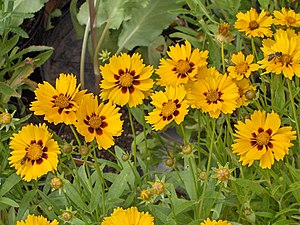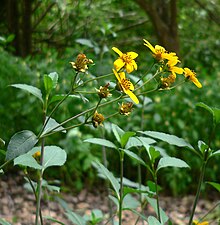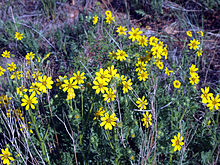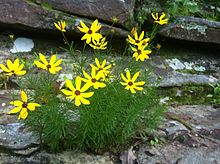Girl eyes
| Girl eyes | ||||||||||||
|---|---|---|---|---|---|---|---|---|---|---|---|---|

Coreopsis lanceolata , cultivated form |
||||||||||||
| Systematics | ||||||||||||
|
||||||||||||
| Scientific name | ||||||||||||
| Coreopsis | ||||||||||||
| L. |
The girl's eye ( Coreopsis ), also beautiful of face called, are a genus within the family of the daisy family (Asteraceae). According to the current scope of the genus, all species occur only in the New World . Some varieties are often grown as ornamental plants.
description

Appearance and leaves
In Coreopsis TYPES is annual or perennial herbaceous plants , more rarely to half-shrubs or shrubs . Most species reach heights of growth of 10 to 80 centimeters, some species reach heights of growth of up to 2 meters or even higher. Many species form rhizomes or sprout base is thickened, a few of the species ( Coreopsis auriculata ) can come up with underground or above-ground foothills spread. In most species, only one independently upright stem is formed per specimen , which are branched more or less over their entire length or only in the upper area.
The leaves can all be the base of all the depending on the type stems be distributed or both; they are opposite or alternate. They can be opposite or alternating, or both. There are kinds of stalked or sessile leaves; both can also occur. There are both species with simple, entire or toothed leaf blades in Coreopsis latifolia , as well as species with leaf blades that are pinnate to deeply lobed. Depending on the species, the leaf surfaces are completely bald or hairy. The leaves of the young plants often differ from the leaves that are formed later.
Inflorescences and flowers
The cup-shaped inflorescences stand together individually at the end of long stems or in loose umbrella-like overall inflorescences . The flower heads contain ray flowers (= ray flowers) and tubular flowers (= disc flowers). In each flower head there are about eight (5 to 13) ray-flowers on the edge, in cultivated forms also more. As a rule, they are yellow, sometimes with a dark, reddish-brown spot at the base, and in some species they are also whitish to reddish hairy. The fertile tubular flowers are also yellow, occasionally at the tip or completely reddish brown.
fruit
The inverted-flattened, more or less spherical to egg-shaped, elongated to linear achenes in outline usually have thin edges or wings. If wings are present, then they are membranous to parchment-like or corky, entire, lobed to toothed and sometimes ciliate. The surfaces of the achenes are smooth, more or less papilose to warty. Depending on the species, a pappus is missing or it consists of two durable bristle caps or scales.
Sets of chromosomes
The basic chromosome number is x = 14.











Systematics and distribution
The genus Coreopsis was established by Carl von Linné . Type species is Coreopsis lanceolata L. Synonyms for Coreopsis L. are: Calliopsis Rchb. , Epilepis Benth. , Leptosyne DC. , Pugiopappus A. Gray , Selleophytum Urb. , Tuckermannia Nutt.
Most of the only New World 35 to 40 species occur in North America (five sections with 25 to 30 species). The centers of biodiversity are Mexico, the Andes, and eastern North America. The species from the Old World now belong to Bidens .
In the genus Coreopsis there are about 35 (previously up to 80 depending on the opinion) species. The Coreopsis are closely related to the Bidens genus and the scope of both genera has long been controversial. The ancient species were placed in the genus Bidens . Coreopsis and Bidens are the two richest genera of the tribe Coreopsideae in the subfamily Asteroideae within the family of the Asteraceae .
The genus Coreopsis is divided into several sections:
- Section Anathysana : It contains only one type:
- Coreopsis cyclocarpa S.F.Blake : The home is the Mexican state of Jalisco.
- Section Calliopsis (Rchb.) Nutt. : It contains only three species from North America to Mexico:
- Coreopsis leavenworthii Torr. & A.Gray : It thrives at altitudes from 0 to about 20 meters only in Florida .:
- Coreopsis paludosa M.E. Jones : It is common in northern Mexico.
- Coreopsis tinctoria Nutt. (Syn .: Coreopsis cardaminifolia . (DC) Nutt. , Coreopsis atkinsoniana Douglas ex Lindl. , Coreopsis bicolor (Rchb) bosses ex Buchenau. ): It is widely used in North America and extends to the Mexican states of Coahuila, Nuevo Leon and Tamaulipas.
- Section Coreopsis : It contains only seven species:
- Coreopsis auriculata L .: It thrives at altitudes of 10 to over 500 meters in large areas of the eastern United States.
- Coreopsis basalis (A.Dietr.) SFBlake (Syn .: Coreopsis drummondii (D.Don) Torr. & A.Gray , Coreopsis wrightii (A.Gray) HMParker ): It thrives at altitudes of 10 to over 300 meters in wide areas the eastern USA.
- Large-flowered girl's eye ( Coreopsis grandiflora Hogg ex Sweet ): It thrives at altitudes of 30 to over 300 meters in wide areas from eastern Canada to the central and eastern USA.
- Coreopsis intermedia Sherff : It grows at altitudes of 60 to 300 meters in the US states southeastern Oklahoma , southwestern Arkansas , Louisiana (only in Caddo Parish) and eastern Texas .
- Lanceolate girl's eye ( Coreopsis lanceolata L. , Syn .: Coreopsis coronata Hook. Non L. , Coreopsis nuecensoides E.B.Sm. ): It thrives at altitudes of 30 to 500, rarely up to 1000 meters in large areas of the central to eastern USA.
- Coreopsis nuecensis A.Heller : It thrives at altitudes from 10 to over 200 meters only in Florida and Texas .
- Coreopsis pubescens Elliott : It thrives at altitudes of 30 to over 1000 meters in large areas of the central to eastern USA.
- Electra section : it contains only two types:
- Coreopsis cuneifolia Greenm. : It occurs only in the Mexican states of southern Durango and Jalisco .
- Coreopsis mutica DC. (Syn .: Coreopsis mexicana (DC.) Hemsl. ): It is distributed from Mexico via Guatemala to Honduras.
- Section Eublepharis Nutt. : It contains only four species, which are mainly found in the eastern United States:
- Coreopsis gladiata Walter (Syn .: Coreopsis falcata F.E.Boynton , Coreopsis floridana E.B.Sm. , Coreopsis helianthoides Beadle , Coreopsis linifolia Nutt. , Coreopsis longifolia Small ): It thrives at altitudes of 10 to over 100 meters in the eastern United States.
- Coreopsis integrifolia Poir. : It thrives at altitudes of 0 to 50 meters in the US states of Florida , Georgia , North Carolina and South Carolina .
- Coreopsis nudata Nutt. : It thrives at altitudes of 10 to over 50 meters in the US states of southern Alabama , northern Florida , southern Georgia , Louisiana (only in St. Tammany Parish) and southern Mississippi .
- Coreopsis rosea Nutt. : It thrives at altitudes of 10 to over 50 meters in the eastern Canadian state of Nova Scotia and in the eastern US states of Massachusetts , New Jersey , eastern Pennsylvania , Rhode Island and Delaware .
- Section Gyrophyllum Nutt. (Syn. Palmatae ): It contains six species that are mainly found in the central to eastern United States:
- Coreopsis delphiniifolia Lam. : It only thrives at altitudes of about 300 meters in the US states of Georgia and South Carolina .
- Coreopsis major Walter : It thrives at altitudes of 300 to 800 meters in large areas of the eastern United States.
- Coreopsis palmata Nutt. : It thrives at altitudes of 100 to 300 meters in the central to eastern United States.
- Coreopsis pulchra F.E.Boynton : It thrives at altitudes of about 300 meters only in the US states of northeast Alabama and northwest Georgia.
- Tall girl's eye ( Coreopsis tripteris L. ): It thrives at altitudes of 100 to 500 meters in the eastern Canadian states of southern Ontario and southern Québec and in the central to eastern United States.
- Whorleaved girl's eye ( Coreopsis verticillata L. ): It thrives at altitudes of 10 to 500 meters in the eastern United States.
- Section Leptosyne (de Candolle) O. Hoffmann : It contains only three species mainly from California to northwestern Mexico:
- Californian girl's eye ( Coreopsis californica (Nutt.) H.Sharsm. ): It thrives at altitudes of 300 to 1000 meters in Arizona and California, and sporadically in New Mexico.
- Douglas Maiden's Eye ( Coreopsis douglasii (DC.) HMHall ): It thrives at altitudes of rarely 150 to, mostly 300 to 1000 meters, only in California .
- Stillman's girl's eye ( Coreopsis stillmanii (A.Gray) SFBlake ): It only thrives in California at altitudes of 400 to 800 meters.
- Section Pseudoagarista : It contains four species in Mexico:
- Coreopsis mcvaughii D.J. Crawford : It occurs only in the southern Mexican states of Aguascalientes and Guanajuato .
- Coreopsis petrophila A. Gray : It is only found in the Mexican states of Durango, Guerrero , Jalisco and Nayarit .
- Coreopsis petrophiloides B.L.Rob. & Greenm. : It occurs only in the Mexican states of Guerrero, Hidalgo , Jalisco, México and Michoacán .
- Coreopsis rudis (Benth.) Hemsl. : It occurs only in the Mexican states of southern Zacatecas and northern Jalisco.
- Section Pugiopappus (A. Gray) SF Blake : It contains only three species that are only found in California:
- Bigelow's girl's eye ( Coreopsis bigelovii ( A.Gray ) Voss ): It occurs in southern California.
- Coreopsis calliopsidea (DC.) A.Gray : It is found in western California.
- Coreopsis hamiltonii (Elmer) H.Sharsm. : It occurs in west-central California.
- Section Silphidium (Torrey & A. Gray) A. Gray : It contains only one species:
- Coreopsis latifolia Michx. : It thrives at altitudes of 300 to 700 meters in the southeastern United States.
- Section Tuckermannia (Nuttall) SF Blake : It contains only two species on the coasts and offshore islands of California and northwestern Mexico:
- Coreopsis gigantea (Kellogg) HMHall : It thrives at altitudes of 0 to 200 meters only from California to Baja California and offshore islands (including the island of Guadalupe ).
- Bare-stemmed girl's eye ( Coreopsis maritima (Nutt.) Hook. F.) : It thrives at altitudes of 0 to 100 meters only in California and offshore islands.
- In the Andes, the three species thrive as shrubs:
- Coreopsis capillacea Kunth
- Coreopsis fasciculata Wedd.
- Coreopsis triloba S.F.Blake : It was first described from Ecuador.
use
Varieties of the following species, for example, play a role as ornamental plants:
- Coreopsis auriculata
- Large-flowered girl's eye ( Coreopsis grandiflora ): Many varieties are used as ornamental plants, the natural form has light yellow flowers.
- Lanceolate girl's eye ( Coreopsis lanceolata ), with lanceolate leaves, often pinnate at the base, and dark yellow or light orange flowers, sometimes with a red-brown point at the base.
- Bare-stemmed girl's eye ( Coreopsis maritima )
- Coreopsis tinctoria , an annual species with a broad, dark red-brown colored flower base. Used to dye textiles and creates a mahogany red.
- Tall girl's eye ( Coreopsis tripteris )
- Whorl-leaved girl's eye ( Coreopsis verticillata ) with leaves that are deeply divided into narrow sections.
swell
- Seung-Chul Kim, Daniel J. Crawford, Mesfin Tadesse, Mary Berbee, Fred R. Ganders, Mona Pirseyedi, Elizabeth J. Esselman: ITS sequences and phylogenetic relationships in Bidens and Coreopsis (Asteraceae). In: Systematic Botany , Volume 24, Issue 3, 1999, pp. 480-493. doi : 10.2307 / 2419701
- Daniel J. Crawford, Mark E. Mort: Phylogeny of Eastern North American Coreopsis (Asteraceae-Coreopsideae): insights from nuclear and plastid sequences, and comments on character evolution. In: American Journal of Botany , Volume 92, Issue 2, 2005, pp. 330-336. doi : 10.3732 / ajb.92.2.330 (sections systematics and distribution)
- John L. Strother: Coreopsis , S. - same text online as printed work , In: Flora of North America Editorial Committee (Ed.): Flora of North America North of Mexico , Volume 21 - Magnoliophyta: Asteridae, part 8: Asteraceae, part 3 (Heliantheae, Eupatorieae) , Oxford University Press, New York and Oxford. June 30, 2006. ISBN 0-19-530565-5 (sections description, distribution and systematics)
Individual evidence
- ↑ a b c d e f g h i j k l m n o p q r s t u v w x y z aa ab ac ad ae af ag John L. Strother: Coreopsis , S. - online with the same text as the printed work , In: Flora of North America Editorial Committee (Ed.): Flora of North America North of Mexico , Volume 21 - Magnoliophyta: Asteridae, part 8: Asteraceae, part 3 (Heliantheae, Eupatorieae) , Oxford University Press, New York / Oxford 2006 . ISBN 0-19-530565-5
- ↑ a b c d e f g h i j k l m n o p q r s t u v w Coreopsis in the Germplasm Resources Information Network (GRIN), USDA , ARS , National Genetic Resources Program. National Germplasm Resources Laboratory, Beltsville, Maryland. Retrieved January 24, 2019.
- ↑ a b c d Daniel J. Crawford, Mark E. Mort: Phylogeny of Eastern North American Coreopsis (Asteraceae-Coreopsideae): insights from nuclear and plastid sequences, and comments on character evolution. In: American Journal of Botany , Volume 92, Issue 2, 2005, pp. 330-336. doi : 10.3732 / ajb.92.2.330
- ↑ Trees and shrubs of the Andes of Ecuador .
- ↑ Gordon Cheers (Ed.): Botanica. The ABC of plants. 10,000 species in text and images . Könemann, Cologne 2003, ISBN 3-8331-1600-5 , p. 250-251 .
